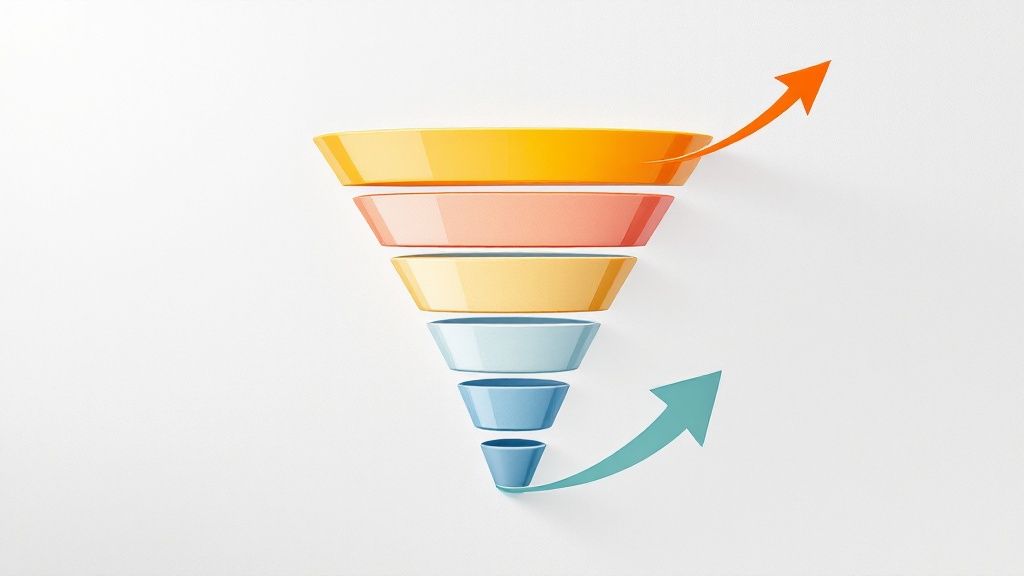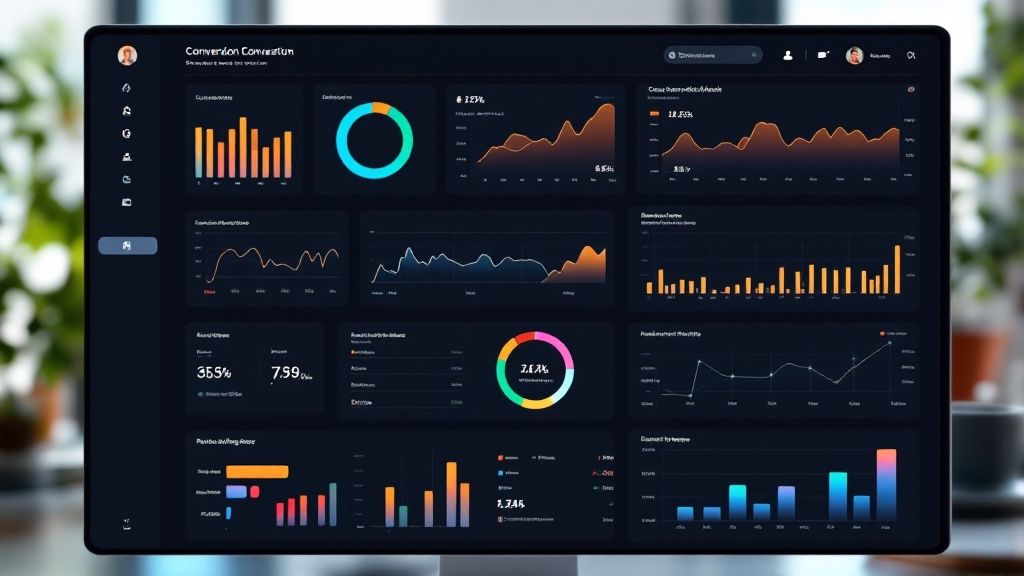Demystifying Conversion Rate Optimization Foundations

Conversion Rate Optimization (CRO) is more than just a popular term; it's a vital process for driving profitability. It involves understanding visitor behavior and using that knowledge to achieve tangible business results. This means building a systematic approach to consistently improve your bottom line, not chasing short-lived trends.
Understanding The Core Principles of CRO
CRO focuses on maximizing the value derived from each website visitor. Rather than constantly pursuing new traffic, it concentrates on converting existing traffic into paying customers or qualified leads. This involves identifying and removing obstacles that prevent visitors from taking desired actions, such as making a purchase, subscribing to a newsletter, or requesting a product demo.
Why Small Improvements Make A Big Difference
Even small improvements in conversion rates can significantly impact revenue. Similar to compound interest, small gains accumulate over time, leading to exponential growth. For example, increasing your conversion rate from 2% to 4% doubles your revenue for the same amount of traffic. CRO is particularly critical in B2B eCommerce, where the average conversion rate is around 1.8%. This low average highlights the substantial potential for improvement using targeted optimization strategies. Consider the case of EcoFoil, which boosted website purchases by 86%. This demonstrates the potential for substantial revenue growth from even minor optimizations. More detailed statistics can be found here: https://www.firework.com/blog/conversion-rate-optimization-statistics
You might also be interested in this article: How to Master Conversion Rate Optimization.
Setting Benchmarks and Measuring Success
Effective CRO requires establishing relevant benchmarks. These benchmarks provide context for your performance and enable progress tracking. Comparing your conversion rates to industry averages and historical data gives a realistic performance overview and facilitates the setting of achievable improvement goals. Furthermore, tracking key metrics such as bounce rate, time on page, and exit rate provides valuable insights into user behavior, helping to pinpoint specific areas for optimization. Consistent monitoring and analysis of these metrics transform CRO from a reactive process into a proactive strategy for continuous improvement.
Decoding User Behavior for Breakthrough Conversions

Going beyond standard website analytics is essential for effective conversion rate optimization (CRO). This involves a deep dive into how users interact with your site, not just the number of visitors. Understanding user behavior is akin to understanding the nuances of your website data. It reveals the reasons behind user actions.
This deeper understanding reveals opportunities to eliminate obstacles hindering conversions and significantly improve your bottom line.
Utilizing Powerful Tools for Behavioral Insights
CRO experts utilize various tools to pinpoint these hidden barriers. Heatmaps, for example, visually represent user clicks, scrolls, and mouse movements, highlighting areas of interest and potential frustration. Hotjar is one platform that provides this type of insightful data.
Session recordings, similarly, offer a "replay" of user interactions. They allow you to observe the actual user journey, including hesitations, errors, and unexpected navigation paths.
Strategic User Testing for Unveiling Friction Points
User testing involves observing real users performing specific tasks on your website. This method reveals friction points in the user journey, such as confusing navigation, unclear calls-to-action, or a difficult checkout process.
These insights allow you to identify where users struggle and what contributes to cart abandonment. For instance, a user test might show that a complicated form or unclear shipping information causes visitors to abandon their carts.
Conversion metrics and user behavior analysis are fundamental to optimizing conversion rates. Experts recommend tracking, analyzing, and optimizing website data to grasp user intent and behavior. Techniques like click density analysis and segmentation help businesses identify user behavior patterns. This data informs strategic changes to improve conversion rates. By analyzing these metrics and improving user experiences, businesses can better guide visitors through the conversion funnel. Learn more about this powerful analytical approach: Learn more about user behavior analysis.
Identifying True Conversion Blockers
Combining data from these tools allows businesses to differentiate between superficial website issues and real conversion blockers. A visually appealing website might make a good first impression, but if users struggle to complete desired actions, the underlying problem needs to be addressed.
This means focusing on fixes that directly improve conversions. These fixes might involve simplifying a form, streamlining the checkout process, or clarifying product information. Understanding user behavior allows you to build a more user-friendly website that guides visitors toward conversion, resulting in increased revenue and a stronger bottom line.
Landing Page Transformation That Drives Action

Landing pages are more than just static online brochures. They are interactive platforms designed to turn casual browsers into loyal customers. This section explores how to transform your landing pages from passive information repositories into dynamic engines of conversion. By studying high-performing landing pages, we can uncover the secrets of effective design and the psychological cues that encourage visitors to take the next step.
Aligning Messaging With Traffic Source Expectations
Effective landing pages tailor their messaging to match the visitor's origin. For instance, someone clicking a Google Ad for "blue running shoes" expects to see a page featuring blue running shoes, not a general shoe catalog. This focused approach increases the chance of a conversion by directly addressing the visitor's initial search intent. This targeted messaging creates a seamless experience, reinforcing the visitor's decision to click. Furthermore, clear and concise headlines that highlight the unique selling points of your product or service are essential for grabbing attention and encouraging further engagement.
Building Trust and Overcoming Hesitation
Building trust is essential for overcoming visitor hesitation and boosting conversions. This can be achieved through incorporating trust signals like customer testimonials, security badges, and satisfaction guarantees. Showcasing positive reviews from happy customers can build confidence and alleviate purchase anxieties. However, these elements should be incorporated strategically to avoid clutter and maintain focus on the call to action. Landing pages play a vital role in conversion rate optimization (CRO), and data reveals the average conversion rate for a lead generation landing page hovers around 11.9%. Moreover, A/B testing landing page designs can boost conversions by 12%, underscoring the importance of continuous improvement. Find more comprehensive statistics here: https://bloggingwizard.com/conversion-rate-optimization-statistics/. A data-driven approach like this ensures landing pages are constantly optimized for maximum effectiveness.
To further illustrate the impact of various landing page elements on conversions, let's take a look at the following table:
Landing Page Element Impact on Conversion This table shows the relative impact of different landing page elements on conversion rates based on A/B testing data.
| Landing Page Element | Average Impact on Conversion | Implementation Difficulty |
|---|---|---|
| Compelling Headline | 10-20% | Low |
| Clear Call to Action | 5-15% | Low |
| Trust Badges | 2-5% | Low |
| Customer Testimonials | 5-10% | Medium |
| High-Quality Images | 3-7% | Medium |
| Mobile Optimization | 5-15% | High |
| Page Load Speed | 2-7% | High |
As you can see, elements like headlines, calls to action, and trust badges can have a significant impact on conversion rates and are relatively easy to implement. More complex changes like mobile optimization and page load speed improvements require more effort but offer substantial returns. Focusing on these key elements can lead to substantial improvements in your landing page performance.
Designing for Conversion-Focused Layouts
Your landing page layout should intuitively guide visitors towards the desired conversion. Imagine a well-designed retail store that effortlessly leads customers through the shopping process. A clear visual hierarchy, strategic placement of calls to action, and minimizing distractions can dramatically improve conversion rates. Using whitespace effectively, grouping related information logically, and incorporating visual cues to draw attention to key elements creates a user-friendly experience.
Optimizing for Mobile Devices
With the increasing dominance of mobile browsing, ensuring your landing pages are mobile-friendly is critical. A responsive design that adapts seamlessly to various screen sizes is crucial for preserving conversion integrity. This means ensuring readability of text, proper scaling of images, and intuitive navigation on smaller screens. This approach guarantees a positive user experience and maximizes conversion potential, irrespective of the device being used.
Continuous Improvement Through Testing
Ongoing optimization is paramount for maximizing landing page performance. Implementing a structured approach to testing and refining elements like headlines, calls to action, and form fields can yield significant improvements. This might involve A/B testing different headline variations or experimenting with the positioning of calls to action. This iterative process enables data-informed decision-making, ensuring your landing pages remain effective in driving conversions over time.
Strategic A/B Testing That Actually Moves Metrics

Conversion Rate Optimization (CRO) relies heavily on A/B testing. However, simply making surface-level changes, like altering button colors without a defined strategy, won't yield significant improvements. Successful A/B testing needs to address the root causes of user frustration. This section explores how to build a strategic A/B testing framework that delivers substantial improvements to your conversion metrics.
Formulating Data-Backed Hypotheses
A clear, data-driven hypothesis is essential before starting any A/B test. This hypothesis should pinpoint the problem, suggest a solution, and predict the expected outcome.
For instance, if your data shows high cart abandonment rates because of a complicated checkout process, your hypothesis could be: "Simplifying the checkout process by reducing the number of required fields will increase the conversion rate by 10%." This data-focused approach ensures your tests are targeted and address areas with the highest potential for improvement.
Designing Effective A/B Tests
Effective A/B testing involves more than just figuring out what to test; it also requires carefully designing the test itself to achieve statistically significant results. This means having a large enough sample size and running the test for an adequate duration to draw reliable conclusions.
Isolating a single variable in each test is also critical. For example, if you’re testing different call-to-action button text, maintain consistent button color and placement. This isolation helps pinpoint the exact element influencing conversion rate changes.
Interpreting Results and Iterating
After your A/B test is complete, analyze the results within the broader context of your business. Even a statistically significant conversion increase might not be practical if it negatively affects other important metrics, such as average order value. This comprehensive perspective ensures your optimization efforts support your overall business objectives.
Furthermore, A/B testing should be an iterative cycle. A successful test can inform further hypotheses and experiments, creating a continuous improvement loop.
Building a Testing Roadmap for Continuous Optimization
Effective teams employ testing roadmaps to organize experiments and monitor progress across various conversion points. This structured approach prevents common testing pitfalls like focusing on minor changes or running too many tests at once.
By strategically organizing your optimization work, you cultivate a culture of continuous improvement and maximize the impact of your CRO strategy. Prioritize tests on high-traffic pages or critical steps in the conversion funnel, like checkout or lead capture forms, for maximum potential impact.
Converting at the Finish Line: Form and Checkout Mastery
The final stages of the conversion funnel are critical. This is where casual browsers transform into paying customers. This section explores practical techniques to optimize your forms and checkout processes, turning potential roadblocks into seamless experiences that boost your conversion rate optimization (CRO) efforts.
Streamlining Forms for Optimal Completion
Lengthy, complicated forms can be a major deterrent for potential customers. Successful brands understand the importance of minimizing form friction. This involves striking a balance between collecting necessary information and keeping the process concise and user-friendly. Analyze your existing forms and ask yourself: are all the fields absolutely essential? Could any data be collected later in the customer journey? Even seemingly small changes, like reducing the number of required fields, can significantly impact completion rates.
Progressive disclosure is a powerful technique that reveals form fields gradually, preventing users from feeling overwhelmed by a long list of inputs. This approach simplifies the process and encourages users to continue. For more complex forms, a multi-step process with a clear progress indicator can reassure users that they are nearing completion, reducing the likelihood of abandonment.
Mastering the Checkout Process
Much like forms, your checkout process needs to be streamlined and intuitive. Research from the Baymard Institute found that 27% of US online shoppers have abandoned an order due to a "too long/complicated checkout process". Minimizing the number of steps, offering guest checkout options, and clearly displaying shipping costs and estimated delivery times can drastically reduce cart abandonment.
Building trust and reassuring customers about the security of their information is also paramount, especially during checkout. Displaying security badges, such as those from trusted providers like Norton, and using secure payment gateways from companies like Stripe and PayPal, builds confidence and reduces the risk of last-minute hesitation.
Mobile Optimization for Seamless Conversions
In our increasingly mobile-centric world, ensuring your forms and checkout processes are optimized for mobile devices is non-negotiable. This means employing responsive design that adapts seamlessly to different screen sizes and ensuring forms are easy to complete on touchscreens. If users struggle to navigate or input information on their mobile devices, they are far more likely to abandon the process.
Harnessing the Power of Micro-Interactions
Effective error handling, clear progress indicators, and visible security reassurance are crucial for overcoming last-minute abandonment. These small, yet powerful, micro-interactions gently guide the user along the path to conversion. Clear and concise error messages help users quickly correct mistakes, while progress indicators provide a sense of accomplishment and encourage completion. Learn more in our article about How to master form design for conversion.
A/B Testing For Continuous Refinement
Continuous A/B testing is vital for pinpointing and eliminating friction points that negatively impact your conversion rates. Experiment with different form layouts, field order, button text, call-to-actions, and checkout options. Analyze the resulting data to determine the most effective strategies for your target audience.
To illustrate the impact various form optimization techniques can have, let's look at the following comparison:
Form Optimization Impact Comparison: Comparison of different form optimization techniques and their impact on conversion rates across various industries
| Optimization Technique | Average Conversion Lift (Example) | Implementation Complexity | Best For |
|---|---|---|---|
| Reducing Form Fields | 5-15% | Low | Long Forms |
| Progressive Disclosure | 10-20% | Medium | Complex Forms |
| Mobile Optimization | 15-25% | High | All Forms & Checkouts |
| Clear Error Messages | 2-5% | Low | All Forms |
| Secure Checkout Display | 5-10% | Medium | E-commerce Checkouts |
This table highlights how seemingly simple adjustments, like reducing form fields or displaying security badges, can yield noticeable improvements in conversion rates. More complex implementations, like mobile optimization, offer potentially higher returns but require more significant investment. By carefully selecting and implementing the right techniques, businesses can effectively improve their conversion rates.
By mastering these techniques, you can transform your forms and checkout processes from conversion barriers into seamless, user-friendly experiences that drive revenue growth. Check out our guide on How to master video marketing. You might be interested in: How to master video marketing.
Building Trust Signals That Overcome Buyer Hesitation
Trust is essential for any successful online business. It's not just a nice-to-have; it's the key to higher conversion rates. This section explores how successful brands leverage trust signals to address visitor concerns and boost their Conversion Rate Optimization (CRO).
The Psychology of Trust Signals
Trust signals have a significant psychological impact on online shoppers. They act as reassurance, easing worries and encouraging conversions. These signals tap into our natural inclination to seek validation before making decisions, especially financial ones. Just as you'd choose a bustling restaurant with good reviews over an empty one with questionable hygiene, online shoppers prefer sites displaying clear trust indicators.
Key Trust Signals and Their Impact
Several trust signals can effectively guide hesitant visitors toward conversion. Social proof, like testimonials and reviews, offers compelling evidence of positive experiences. For instance, displaying "95% of customers would recommend our product" can significantly increase buyer confidence. Security indicators, such as SSL certificates and secure payment gateway logos, assure visitors their data is safe. This is crucial on checkout pages, where data security concerns are often highest. Strong guarantees, like money-back offers or free returns, mitigate perceived risk and encourage purchases. A satisfaction guarantee makes potential buyers more comfortable trying your product.
Identifying Trust Barriers for Your Audience
Trust barriers differ across audience segments. Younger demographics might be influenced by social media endorsements, while older audiences might prioritize secure payment options. Analyzing user behavior, conducting surveys, and gathering customer feedback can help identify the specific trust concerns of your target audience. Understanding these concerns is essential for choosing the right trust elements to implement.
Implementing Trust Signals Without Clutter
While trust signals are essential, overcrowding can overwhelm visitors and distract from the conversion path. Strategic placement is key. Security badges should be near payment fields, while testimonials can be interspersed within product descriptions or on dedicated landing pages. This thoughtful integration enhances user experience and strengthens CRO efforts without creating visual clutter.
Tailoring Trust Signals to Different Business Models
The most effective trust signals depend on the business model and industry. An e-commerce site might focus on secure checkout and return policies, while a SaaS company might emphasize customer testimonials and security certifications. Tailoring signals ensures relevance and maximizes their impact. Learn more in our article about Our Terms of Service. You might be interested in: Our Terms of Service.
Real-World Examples and Implementation Guidelines
Many companies demonstrate the power of trust signals. Amazon effectively uses customer reviews and secure checkout processes, contributing to their high conversion rates. Zappos has built a reputation for exceptional customer service and hassle-free returns, fostering trust and loyalty. By studying successful implementations and adapting them to your needs, you can effectively build trust and overcome buyer hesitation.
Ready to enhance your video marketing and boost conversions? Visit Sprello today and explore how AI-powered influencers can create engaging video content.



